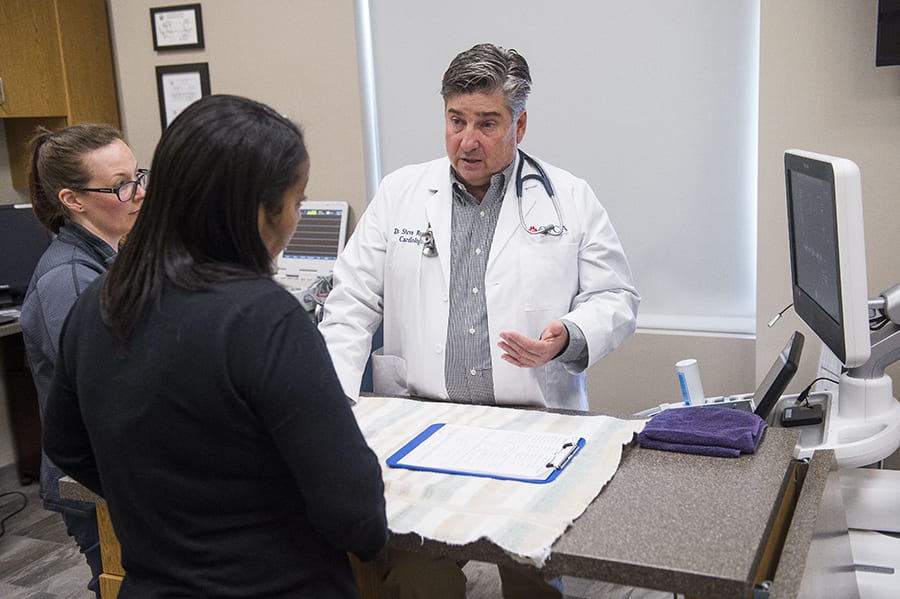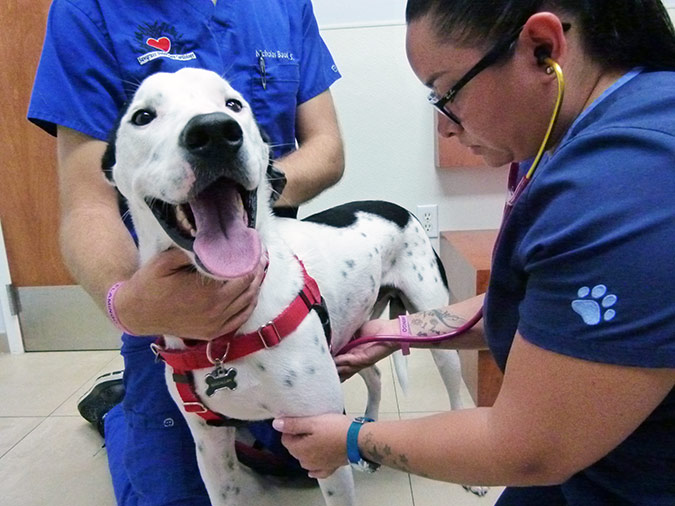What You Need to Learn About Vet Providers: An Introduction of Diagnostic Devices and Procedures
Veterinary services play a crucial duty in maintaining the wellness of animals. Routine examinations can reveal covert wellness problems early. Numerous diagnostic tools and procedures, such as blood tests and imaging strategies, give vital insights into an animal's wellness. Understanding these techniques is essential for pet dog owners. What details diagnostic procedures are most commonly used, and just how can they impact an animal's treatment strategy?
Importance of Normal Vet Exams
While several animal proprietors may underestimate the significance of normal veterinary exams, these consultations are necessary for preserving an animal's overall wellness. Regular brows through to the vet permit early detection of potential wellness problems before they escalate into major issues. Routine exams often consist of inoculations, which are very important for avoiding transmittable conditions that could seriously affect an animal's well-being. Furthermore, these visits supply a chance for veterinarians to examine the pet's weight, dental health and wellness, and overall problem, making sure that the pet is growing. During these brows through, pet proprietors can likewise obtain useful suggestions on diet regimen, workout, and preventative care customized to their specific pet dog's demands.
Typical Analysis Treatments in Veterinary Medicine
In vet medicine, exact diagnosis is important for reliable treatment. Usual analysis treatments consist of blood testing techniques, advanced imaging innovations, and urinalysis, each playing a significant duty in identifying wellness issues. Understanding these approaches improves the capacity to give proper treatment for pet individuals.
Blood Examining Methods
Blood screening techniques serve as important analysis devices in veterinary medicine, making it possible for veterinarians to assess the health and wellness of animals properly. These strategies entail gathering blood examples to evaluate numerous components, such as white and red blood cells, platelets, and biochemical markers. Usual tests consist of full blood counts (CBC), which examine total health and wellness and detect infections, and biochemical panels, which examine organ function and metabolic condition. Additionally, serological examinations can identify specific conditions through antibody detection. Blood testing is minimally intrusive and provides important details that helps in diagnosing conditions, keeping an eye on wellness standing, and assessing feedbacks to treatments. On the whole, these methods play an important duty in guaranteeing optimal look after animals and animals alike.
Imaging Technologies Utilized
Diagnostic imaging innovations are vital devices in vet medicine, matching blood screening methods by offering visual insights into a pet's interior frameworks. Typical imaging modalities include X-rays, which work for reviewing bone cracks and spotting foreign things, and ultrasound, which permits real-time visualization of soft tissues and body organs. Magnetic vibration imaging (MRI) offers comprehensive photos of intricate physiological areas, particularly in neurological evaluations. Calculated tomography (CT) supplies cross-sectional images, boosting analysis accuracy for different problems. Each of these innovations aids vets in detecting illnesses, planning treatments, and checking healing. By integrating imaging innovations, veterinary professionals can much better evaluate an animal's health and wellness and make informed choices concerning their care.
Urinalysis and Diagnostics
Urinalysis serves as a vital analysis device in vet medication, offering valuable understandings right into an animal's total wellness and helping in the detection of various conditions. This non-invasive procedure analyzes pee examples to analyze kidney function, hydration status, and metabolic disorders. Common components analyzed consist of details gravity, pH degrees, glucose, healthy proteins, and the presence of blood or germs. Uncommon searchings for can suggest problems such as urinary tract infections, diabetes mellitus, or kidney illness. To improve diagnostic accuracy, urinalysis is usually done in combination with various other tests, such as blood work and imaging research studies. Early detection with urinalysis can cause timely interventions, enhancing the prognosis for several veterinary individuals. Therefore, it is a necessary aspect of complete vet care.
Recognizing Blood Tests and Laboratory Analysis
Comprehending blood examinations and laboratory analysis is important in vet medicine as it aids in detecting different health problems in pets. Different kinds of blood tests provide essential information concerning an animal's internal state, while interpreting lab results needs careful consideration of numerous elements. This area will certainly discover the sorts of blood tests available and the relevance of their results.
Kinds Of Blood Tests
Blood tests play an essential function in vet medicine, supplying crucial insights into an animal's health standing. Numerous kinds of blood examinations are made use of, each offering different purposes. Total blood counts (CBC) evaluate overall health and detect conditions such as anemia or infection. Biochemical accounts review body organ function by measuring electrolytes and enzymes, supplying understandings into metabolic wellness. Serological tests identify specific antibodies or virus, aiding in the diagnosis of infections or autoimmune diseases. Blood typing warranties risk-free transfusions, while coagulation examinations evaluate the blood's ability to embolisms, essential for medical treatments. These tests jointly boost diagnosis, therapy preparation, and surveillance of an animal's health, highlighting the value of extensive laboratory analysis in veterinary care.

Interpreting Lab Outcomes
A detailed analysis of lab results is essential for accurate diagnosis and treatment in vet medication. Translating lab results calls for an understanding of regular reference arrays and the significance of inconsistencies. Blood tests can disclose various health indicators, such as organ feature, electrolyte equilibrium, and the visibility of infections. Vets have to take into consideration the entire medical picture, including the animal's background, physical exam searchings for, and any kind of signs and symptoms offered. Variations in results may arise from variables such as age, type, and underlying wellness problems. Lab outcomes must not be viewed in isolation yet rather as component of an all-encompassing diagnostic technique. Exact analysis enables tailored treatment plans and better end results for veterinary people.
Imaging Techniques: X-rays, Ultrasounds, and Beyond
Imaging techniques are vital tools in vet medicine, supplying crucial insights right into the health and wellness and wellness of animals. Amongst one of the most generally utilized techniques are Ultrasounds and x-rays. X-rays are important for visualizing bone structures, aiding vets identify fractures, lumps, or foreign items. This approach is non-invasive and fast, making it optimal for urgent situations.Ultrasounds, on the other hand, utilize sound waves to create photos of soft tissues and organs. This technique is particularly useful for taking a look at the heart, abdomen, and reproductive organs, allowing vets to analyze conditions like liquid buildup or organ abnormalities.Beyond X-rays and ultrasounds, advanced imaging techniques such as computed tomography (CT) and magnetic resonance imaging (MRI) are significantly used in vet technique. These methods provide detailed cross-sectional pictures, enhancing look here the precision of diagnoses and treatment strategies. Ultrasound For Dogs. In general, imaging methods play an essential function in making certain effective veterinary care
The Function of Biopsies in Diagnosing Pet Dog Wellness Issues
Precision in diagnosing health problems in family pets often rests on the use of biopsies, which supply clear-cut details concerning cells abnormalities. A biopsy involves the removal of a small sample of tissue for assessment under a microscopic lense, enabling vets to determine numerous conditions, consisting of infections, tumors, and inflammatory illness. This diagnostic tool is necessary for identifying between deadly and benign growths, guiding treatment decisions, and assessing the severity of a condition.Biopsies can be done using various techniques, such as needle aspiration, incisional biopsies, or excisional biopsies, depending on the area and sort of cells entailed. The selection of technique may affect recuperation time and the quantity of tissue collected. Ultimately, the info obtained from a biopsy can cause targeted therapies, improving outcomes for pets encountering serious health and wellness challenges. Vets highlight the significance of this treatment in accomplishing precise medical diagnoses and reliable treatment plans.
Advanced Diagnostic Tools: Endoscopy and CT Checks

Advanced analysis tools, such as endoscopy and CT scans, play a vital role in contemporary vet medicine, using non-invasive methods to envision internal structures and detect various conditions in pet dogs. Endoscopy involves the usage of an adaptable tube geared up with a camera, enabling vets to examine the intestinal tract and respiratory system straight. This method can reveal abnormalities such as lumps, foreign bodies, or swelling, making it possible for targeted treatment plans.CT scans, on the other hand, make use of sophisticated imaging technology to create thorough cross-sectional images of the body (CT Scans For Dogs). This approach is especially beneficial for evaluating complicated frameworks like the mind, back, and joints. By giving high-resolution photos, CT scans assist vets in recognizing concerns that might not appear through standard radiography. With each other, these sophisticated devices improve diagnostic accuracy, improve treatment outcomes, and ultimately add to better total pet dog wellness monitoring

Translating Examination Results: What Pet Dog Owners Ought To Know
Recognizing test outcomes can be a challenging task for pet dog owners, particularly after sophisticated procedures like endoscopy and CT scans have actually been performed. Translating these outcomes needs an understanding of medical terms and a clear understanding of what the searchings for indicate regarding the pet dog's health and wellness. Vets often provide descriptions, yet the complexity of the results can still bring about confusion.Pet owners should proactively participate in discussions with their veterinarians, asking questions to clear up any kind of unpredictabilities. It is important to recognize unusual versus typical results and the implications for the animal's therapy strategy. In addition, identifying that some outcomes might call for further testing or monitoring can assist owners stay notified regarding their family pet's wellness trip. Inevitably, a joint approach between pet owners and veterinary experts promotes much better health try this out and wellness results and improves the general treatment experience for animals.
Often Asked Concerns
Exactly how Do I Pick the Right Vet Center for My Family pet?
Picking the ideal veterinary facility involves researching local alternatives, assessing certifications, going to centers, and assessing staff interactions (Cancer Veterinary Near Me). Prioritizing referrals from relied on sources can help assure the most effective care and environment for a pet's wellness demands
What Should I Do if My Pet Dog Declines to Go to the Veterinarian?
When a pet rejects to visit the vet, it's advisable to remain calm, use treats or playthings to lure them, and think about scheduling a home see if anxiousness lingers. Perseverance and favorable reinforcement are crucial.
Are There Telehealth Options for Vet Solutions?
Telehealth alternatives for veterinary solutions are significantly readily available, permitting family pet proprietors to seek advice from with veterinarians from another location. These solutions make it possible for conversations regarding health and wellness issues, guidance on minor ailments, and follow-ups without requiring to check out a facility.
Just how Commonly Should My Family Pet Have Dental Check-Ups?
The frequency of oral examinations for animals usually depends upon their age and breed. Generally, vets advise yearly oral examinations, although some family pets may require more regular check outs to maintain optimal oral health.

What Are the Costs Connected With Vet Diagnostics?
The expenses associated with veterinary diagnostics can differ extensively, normally varying from standard examinations like blood work to advanced imaging methods. Aspects affecting expenditures consist of the facility's area, tools used, and specific tests required for each animal. Veterinary solutions play a vital role in maintaining the health of pets. While several pet dog proprietors might take too lightly the value of normal vet exams, these visits are necessary for keeping a pet's go to the website general health and wellness. Additionally, these appointments provide an opportunity for vets to assess the animal's weight, dental health, and overall problem, ensuring that the family pet is prospering. Precision in diagnosing health concerns in family pets frequently hinges on the use of biopsies, which provide conclusive details concerning cells irregularities. Furthermore, recognizing that some results might require more screening or monitoring can aid owners stay informed concerning their pet dog's wellness trip.
Comments on “How a Cancer Veterinary Near Me Offers Advanced Oncology Services for Pets}”